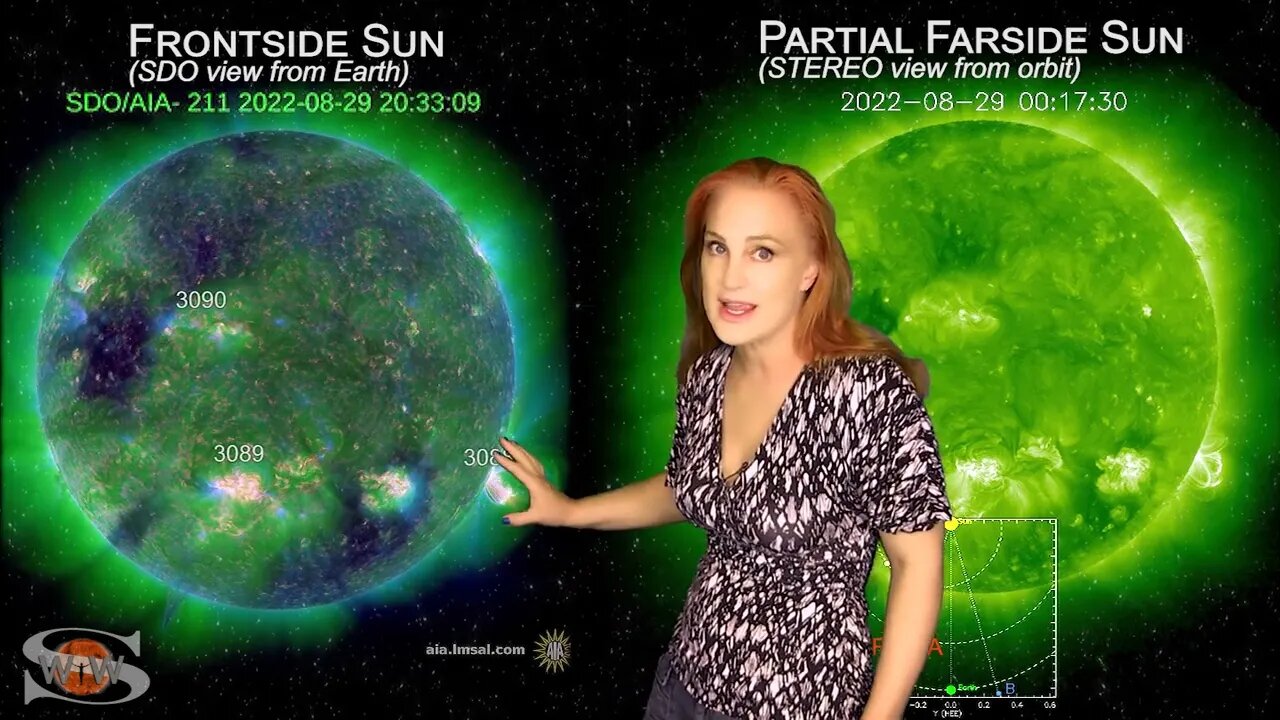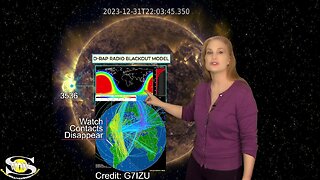Premium Only Content

Fast Wind Comes Before Flares Return | Space Weather News 09.02.2022
This Space Weather News forecast sponsored in part by Millersville University:
https://www.millersville.edu/swen
This week our Sun is trading big flare-players for a nice chance for aurora. We say goodbye to region 3088 as it rotates off the Sun's west limb and to the farside. Guaranteed we will keep a close watch on it to see whether it survives the next two weeks and will return. Meanwhile we have a large coronal hole that will be sending us some fast solar wind starting around September 4th. Last month this coronal hole bumped us to G2-level storm conditions and there is a good chance it will do the same this time as well. Aurora photographers should get ready for a decent show, even down to mid-latitudes as we could see some sustained views ramping up late September 3, peaking on September 4 through 5, and then ramping down through September 6 and 7. Overall, this could make up for some of the solar storm fizzles we have seen from the big flare players (who obviously have very bad aim). Amateur radio operators and GPS users may get a bit of a reprieve on Earth's dayside from radio blackouts this week, but once the solar storm hits, expect signal disruptions on Earth's nightside, especially anywhere near aurora. Learn the details of the coming solar storm, watch region 3088 rotate out of view with a bang, & see why the radio-quiet conditions will not last for long, with new regions about to rotate into view.
Want early access to these forecasts, tutorials on Space Weather, & more? Visit:
https://patreon.com/SpaceweatherWoman
For daily and often hourly updates (during active times) visit me on Twitter:
https://twitter.com/TamithaSkov
For a more in-depth look at the data and images highlighted in this video see these links below.
Solar Imaging and Analysis:
SDO: http://sdo.gsfc.nasa.gov/data/
Helioviewer: http://www.helioviewer.org/
Flare Analysis: http://www.lmsal.com/solarsoft/latest_events/
Computer Aided CME Tracking CACTUS: http://www.sidc.oma.be/cactus/out/latestCMEs.html
GOES Xray: http://www.swpc.noaa.gov/rt_plots/xray_1m.html
SOHO: http://sohodata.nascom.nasa.gov/
Stereo: http://stereo.gsfc.nasa.gov/
GONG magnetic field synoptic movie: https://gong.nso.edu/data/magmap/standard_movie.html
GONG magnetic field synoptic charts: http://gong.nso.edu/data/magmap/
LMSAL Heliophysics Events HEK http://www.lmsal.com/isolsearch
Solar Wind:
DISCOVR solar wind: http://www.swpc.noaa.gov/products/real-time-solar-wind
ACE Solar Wind: http://www.swpc.noaa.gov/products/ace-real-time-solar-wind
NASA ENLIL SPIRAL: https://iswa.gsfc.nasa.gov/IswaSystemWebApp/iSWACygnetStreamer?timestamp=2038-01-23+00%3A44%3A00&window=-1&cygnetId=261
NOAA ENLIL SPIRAL: http://www.swpc.noaa.gov/products/wsa-enlil-solar-wind-prediction
Magnetosphere, Ionosphere, Atmosphere:
GOES Magnetometer: http://www.swpc.noaa.gov/products/goes-magnetometer
Ionosphere D-Region Absorption (DRAP) model: http://www.swpc.noaa.gov/products/d-region-absorption-predictions-d-rap/
Radio Propagation: https://www.tvcomm.co.uk/g7izu/atlantic-mf-hf-propagation-20min-persistence/
Near-Earth radiation environment: https://spaceweather.gfz-potsdam.de/products-data/forecasts
Auroral Oval Ovation Products: http://www.swpc.noaa.gov/products/aurora-30-minute-forecast
Global 3-hr Kp index: http://www.swpc.noaa.gov/products/planetary-k-index
Wing Kp index prediction: http://www.swpc.noaa.gov/products/wing-kp
USGS Ground Magnetometers: http://geomag.usgs.gov/realtime/
USGS Disturbance Storm-Time (Dst): http://geomag.usgs.gov/realtime/dst/
NAIRAS Radiation Storm Model: http://sol.spacenvironment.net/raps_ops/current_files/globeView.html
Multi-Purpose Space Environment Sites:
NOAA/SWPC: http://www.swpc.noaa.gov
SOLARHAM: http://www.solarham.net/index.htm
Spaceweather: http://spaceweather.com
iSWA: http://iswa.gsfc.nasa.gov/iswa/iSWA.html
Definition of Geomagnetic Storm, Radiation Storm, and Radio Blackout Levels:
http://www.swpc.noaa.gov/NOAAscales/
None of this would be possible without the hard work and dedication of those who have provided all of this data for public use.
Images c/o NASA/ESA/CSA (most notably the superb SDO, SOHO, ACE, STEREO, CCMC, JPL & DSN teams, amazing professionals, hobbyists, institutions, organizations, agencies and amateurs such as those at the USAF/HAARP, NICT, NOAA, USGS, Environment Canada, Natural Resources Canada, Intellicast, Catatania, rice.edu, wisc.edu, sonoma.edu ucalgary.ca, rssi.ru, ohio-state.edu, solen.info, and more. Thanks for making Space Weather part of our every day dialogue.
-
 12:43
12:43
Dr. Tamitha Skov
1 year ago $0.22 earnedBiggest X-Flare of Cycle 25 & Super Storm Launch | Space Weather Spotlight 02 January 2024
585 -
 59:57
59:57
The StoneZONE with Roger Stone
11 hours agoJ6 Martyr Enrique Tarrio Describes Inhumane Prison Conditions Ordered by Biden | The StoneZONE
47.4K4 -
 16:48
16:48
Tundra Tactical
11 hours ago $9.65 earnedAffordable Medical Gear From ACETAC SHOT Show 2025
84.8K4 -
 1:46:16
1:46:16
Redacted News
14 hours agoRFK CONFIRMATION: Kennedy goes to WAR with Big Pharma Democrats in Fiery Hearing | Redacted Live
264K431 -
 57:31
57:31
Candace Show Podcast
14 hours agoBREAKING! Taylor Swift Turns Against Blake Lively & Ryan Reynolds | Candace Ep 141
241K177 -
 1:04:59
1:04:59
Sarah Westall
11 hours agoRFK Jr Report, Constitution Suspended, War Time Procedures in Place, WHO Exit, DOD w/ Sasha Latypova
81K34 -
 1:56:37
1:56:37
Melonie Mac
15 hours agoGo Boom Live Ep 35!
69.6K15 -
 1:01:13
1:01:13
LFA TV
18 hours agoPRESIDENT TRUMP SIGNS LAKEN RILEY ACT | BASED AMERICA 1.29.25 6pm
74.5K8 -
 1:43:07
1:43:07
2 MIKES LIVE
12 hours ago2 MIKES LIVE #172 News Breakdown Wednesday!
40.4K2 -
 1:26:16
1:26:16
The Big Mig™
13 hours agoJ6’r Ryan Samsel Free At Last The BOP & DOJ Exposed
39K4